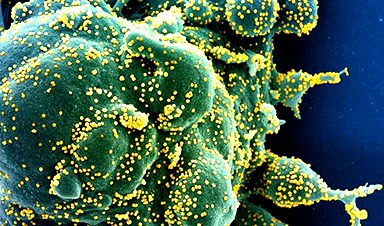The COVID-19 pandemic has prompted considerable investigation into how the SARS-CoV-2 Spike protein attaches to a human cell during the infection process, as this knowledge is useful in designing vaccines and therapeutics. Now, a team of scientists has discovered additional locations on the Spike protein that may not only help to explain how certain mutations make emerging variants more infectious but also could be used as additional targets for therapeutic intervention.
“Significant research is underway to examine how the receptor binding domain (RBD) at the tip of the club-shaped SARS-CoV-2 Spike protein attaches to an ACE2 receptor on a human cell, but little is known about the other changes that occur in the Spike protein as a result of this attachment,” said Ganesh Anand, associate professor of chemistry, Penn State. “We have uncovered ‘hotspots’ further down on the Spike protein that are critical for SARS-CoV-2 infection and may be novel targets beyond the RBD for therapeutic intervention.”
Anand and his colleagues used a process, called amide hydrogen-deuterium exchange mass spectrometry (HDXMS), to visualize what happens when the SARS-CoV-2 Spike protein binds to an ACE2 receptor. HDXMS uses heavy water or deuterium oxide (D2O), a naturally occurring, non-radioactive isotope of water formed from heavy hydrogen or deuterium, as a probe for mapping proteins. In this case, the team placed SARS-CoV-2 Spike protein and ACE2 receptors in heavy water and obtained footprints of ACE2 on the Spike protein.
“If you put the Spike protein and ACE2 receptor into a solution that’s made with D2O, the surfaces and more floppy regions on both proteins will more readily exchange hydrogens for deuterium, compared to their interiors,” said Anand. “And footprints of each protein on the binding partner can be readily identified from areas where you see little deuterium and only detect normal hydrogen.”
Using this technique, the team determined that binding of the Spike protein and ACE2 receptor is necessary for furin-like proteases—a family of human enzymes—that act to snip off the tip, called the S1 subunit, of the Spike protein, which is the next step in the virus’s infection of the cell. The findings published on Feb. 8 in the journal eLife.
Image Credit: NIH/NIAID
Post by Amanda Scott, NA CEO. Follow her on twitter @tantriclens
Thanks to Heinz V. Hoenen. Follow him on twitter: @HeinzVHoenen
News
New study suggests a way to rejuvenate the immune system
Stimulating the liver to produce some of the signals of the thymus can reverse age-related declines in T-cell populations and enhance response to vaccination. As people age, their immune system function declines. T cell [...]
Nerve Damage Can Disrupt Immunity Across the Entire Body
A single nerve injury can quietly reshape the immune system across the entire body. Preclinical research from McGill University suggests that nerve injuries may lead to long-lasting changes in the immune system, and these [...]
Fake Science Is Growing Faster Than Legitimate Research, New Study Warns
New research reveals organized networks linking paper mills, intermediaries, and compromised academic journals Organized scientific fraud is becoming increasingly common, ranging from fabricated research to the buying and selling of authorship and citations, according [...]
Scientists Unlock a New Way to Hear the Brain’s Hidden Language
Scientists can finally hear the brain’s quietest messages—unlocking the hidden code behind how neurons think, decide, and remember. Scientists have created a new protein that can capture the incoming chemical signals received by brain [...]
Does being infected or vaccinated first influence COVID-19 immunity?
A new study analyzing the immune response to COVID-19 in a Catalan cohort of health workers sheds light on an important question: does it matter whether a person was first infected or first vaccinated? [...]
We May Never Know if AI Is Conscious, Says Cambridge Philosopher
As claims about conscious AI grow louder, a Cambridge philosopher argues that we lack the evidence to know whether machines can truly be conscious, let alone morally significant. A philosopher at the University of [...]
AI Helped Scientists Stop a Virus With One Tiny Change
Using AI, researchers identified one tiny molecular interaction that viruses need to infect cells. Disrupting it stopped the virus before infection could begin. Washington State University scientists have uncovered a method to interfere with a key [...]
Deadly Hospital Fungus May Finally Have a Weakness
A deadly, drug-resistant hospital fungus may finally have a weakness—and scientists think they’ve found it. Researchers have identified a genetic process that could open the door to new treatments for a dangerous fungal infection [...]
Fever-Proof Bird Flu Variant Could Fuel the Next Pandemic
Bird flu viruses present a significant risk to humans because they can continue replicating at temperatures higher than a typical fever. Fever is one of the body’s main tools for slowing or stopping viral [...]
What could the future of nanoscience look like?
Society has a lot to thank for nanoscience. From improved health monitoring to reducing the size of electronics, scientists’ ability to delve deeper and better understand chemistry at the nanoscale has opened up numerous [...]
Scientists Melt Cancer’s Hidden “Power Hubs” and Stop Tumor Growth
Researchers discovered that in a rare kidney cancer, RNA builds droplet-like hubs that act as growth control centers inside tumor cells. By engineering a molecular switch to dissolve these hubs, they were able to halt cancer [...]
Platelet-inspired nanoparticles could improve treatment of inflammatory diseases
Scientists have developed platelet-inspired nanoparticles that deliver anti-inflammatory drugs directly to brain-computer interface implants, doubling their effectiveness. Scientists have found a way to improve the performance of brain-computer interface (BCI) electrodes by delivering anti-inflammatory drugs directly [...]
After 150 years, a new chapter in cancer therapy is finally beginning
For decades, researchers have been looking for ways to destroy cancer cells in a targeted manner without further weakening the body. But for many patients whose immune system is severely impaired by chemotherapy or radiation, [...]
Older chemical libraries show promise for fighting resistant strains of COVID-19 virus
SARS‑CoV‑2, the virus that causes COVID-19, continues to mutate, with some newer strains becoming less responsive to current antiviral treatments like Paxlovid. Now, University of California San Diego scientists and an international team of [...]
Lower doses of immunotherapy for skin cancer give better results, study suggests
According to a new study, lower doses of approved immunotherapy for malignant melanoma can give better results against tumors, while reducing side effects. This is reported by researchers at Karolinska Institutet in the Journal of the National [...]
Researchers highlight five pathways through which microplastics can harm the brain
Microplastics could be fueling neurodegenerative diseases like Alzheimer's and Parkinson's, with a new study highlighting five ways microplastics can trigger inflammation and damage in the brain. More than 57 million people live with dementia, [...]





















